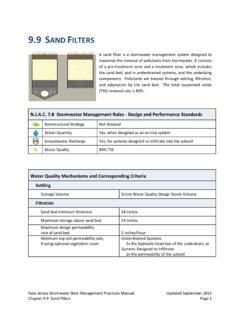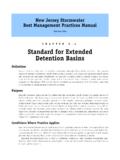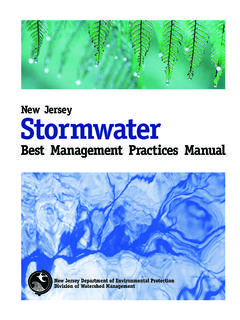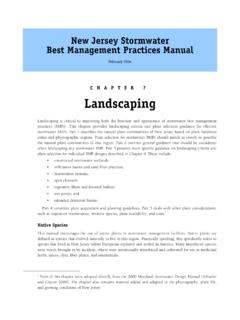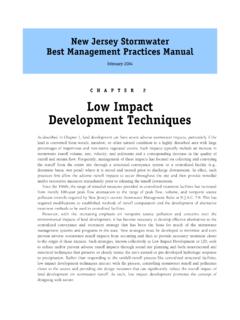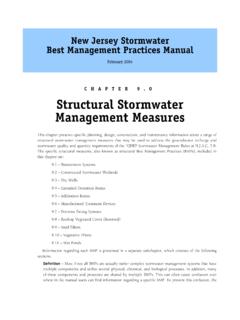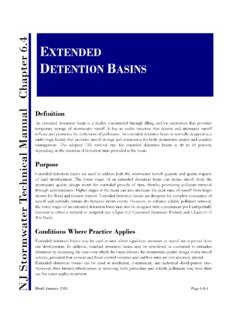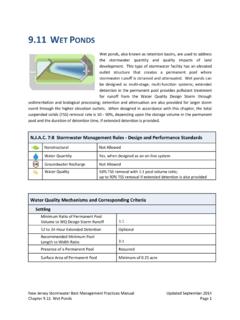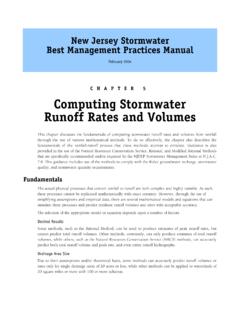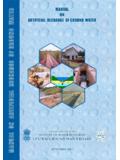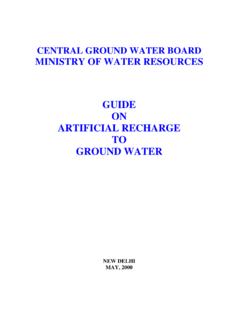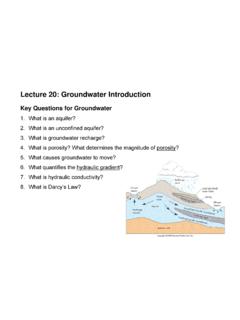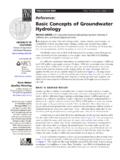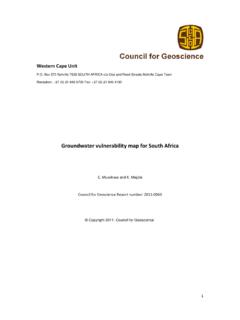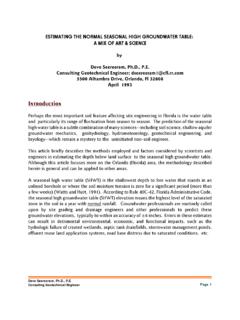Transcription of CHAPTER 6 Groundwater Recharge - njstormwater.org
1 New Jersey StormwaterBest Management Practices ManualApril 2004 CHAPTER 6 Groundwater RechargeThis CHAPTER presents the standards, data, and procedures necessary to meet the Groundwater rechargerequirements of the NJDEP Stormwater Management Rules at 7:8. According to these Rules, a major development project, which is one that disturbs at least 1 acre of land or creates at least acresof new or additional impervious surface, must include nonstructural and/or structural stormwatermanagement measures that prevent the loss of Groundwater Recharge at the project site.
2 This requirement isincluded in the Rules because the loss of Groundwater Recharge can adversely impact the health of streamsand wetlands and the yield of water supply wells. Urban redevelopment and certain linear developmentprojects are exempt from the Groundwater Recharge requirements, while waivers may obtained under certainconditions for public roadway, railroad, and pedestrian walkway enlargements. Complete details can befound in Subchapter 5 of the Stormwater Management , the Stormwater Management Rules require that a proposed major land development complywith one of the following two Groundwater Recharge requirements:Requirement 1:That 100 percent of the site s average annual pre-developed Groundwater rechargevolume be maintained after development.
3 OrRequirement 2:That 100 percent of the difference between the site s pre- and post-development 2-Year runoff volumes be Stormwater Management Rules allow the site designer to select which requirement to follow. TheRules also state that compliance with either of the above alternative requirements must be demonstratedthrough hydrologic and hydraulic analysis. Regardless of which alternative requirement is selected, such ananalysis will generally begin with a computation of the existing (or pre-developed) hydrologic conditions atthe proposed development site.
4 In the case of Requirement 1, these conditions will focus on the annualamount of Groundwater Recharge that occurs at the site under pre-developed conditions while, forRequirement 2, the focus will instead be on the pre-developed volume of 2-Year site computations will then be followed by similar ones for the proposed (or post-developed) conditionsat the site. A comparison of the results of either of these pre- and post-development computations will thenyield the annual volume of Groundwater that must be recharged (Requirement 1) or 2-Year storm runoffvolume that must be infiltrated (Requirement 2) through one or more structural Recharge or infiltrationBMPs.
5 Ideally, the planning and design of the proposed site will have incorporated nonstructural measures tosuch an extent that the need for structural facilities is reduced to a practical Jersey Stormwater Best Management Practices Manual CHAPTER 6: Groundwater Recharge April 2004 Page 6-2 Finally, once the analysis of pre- and post-development conditions has established the need for structuralrecharge (Requirement 1) or infiltration (Requirement 2) BMPs, the hydrologic and hydraulic analysiswould next focus on the actual design of such facilities.
6 This process would include answering suchquestions such as: Should the required Recharge or infiltration be achieved at a single facility or several locatedthroughout the development site? Should the facilities be located above or below ground? Which portions of the development site should be utilized to generate runoff to the facilities? What facility dimensions are required? Where should the facilities be located on the site relative to buildings, septic systems, propertylines, and other sensitive areas?This CHAPTER presents the Groundwater Recharge information necessary to perform the hydrologic andhydraulic analysis required for Requirement 1 (maintaining pre-developed annual Recharge volumes).
7 Information necessary for the analysis required for Requirement 2 (infiltrating the increased 2-Year runoffvolume) is presented in CHAPTER 5: Computing Stormwater Runoff Rates and Volumes. Design informationregarding structural Recharge and infiltration BMPs can be found in this CHAPTER and CHAPTER 9: StructuralStormwater Management both the NJDEP Stormwater Management Rules and this manual, Groundwater Recharge is defined asprecipitation that infiltrates into the soil and is not evapotranspired. Instead, the infiltrated precipitationmoves downward to a depth below the root zone of the surface vegetation, where it cannot be removed bythat vegetation through uptake and evapotranspiration.
8 At such a depth, it is considered available to enterthe soil s saturated zone and become Groundwater . The role of Groundwater Recharge in the overallhydrologic cycle is illustrated in Figure 6-1 6-1: Groundwater Recharge in the Hydrologic CycleSource: New Jersey Geological Survey Report Jersey Stormwater Best Management Practices Manual CHAPTER 6: Groundwater Recharge April 2004 Page 6-3 According to the New Jersey Geological Survey (NJGS):The potential for natural Groundwater Recharge begins with precipitation (rain, snow, hail, sleet).
9 Someof the precipitation never seeps into the soil, but instead leaves the system as surface runoff. The waterthat seeps into the soil is infiltration. Part of the water that does infiltrate is returned to the atmospherethrough evapotranspiration. Evapotranspiration refers to water that is returned to the atmospherefrom vegetated areas by evaporation from the soil and plant surfaces and soil water that is taken up byplant roots and transpired through plant leaves or needles. Infiltrated water that is not returned to theatmosphere by evapotranspiration moves vertically downward and, upon reaching the saturated zone,becomes ground water.
10 This ground water could be in a geologic material that is either an aquifer ornonaquifer, depending on whether it can yield satisfactory quantities to wells. (NJGS GSR-32)In addition to supplying water to wells, Groundwater can also provide base flow to streams, wetlands,and other water bodies, directly affecting the ecology and geomorphology of these potentially adverse impacts of land development on Groundwater Recharge have long beenrecognized. From the description presented above, it can be seen that land development activities that eithercover permeable soils with impervious surfaces or reduce the soils permeability through disturbance andcompaction will reduce the rate of Groundwater Recharge that occurs under pre-developed site noted above, such reductions in Groundwater Recharge can adversely impact streams, wetlands, andother water bodies by reducing the volume and rate of base flow to them.
